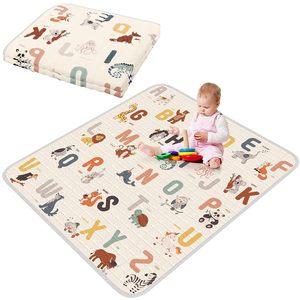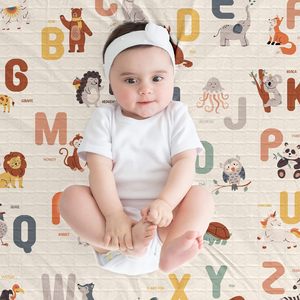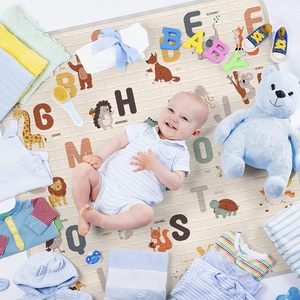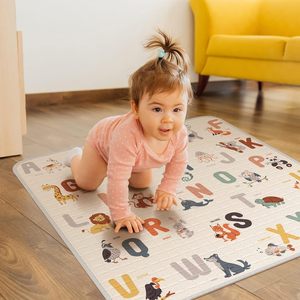(6968 products available)

























































































































































































































































Washable baby play mats come in different types, which include the following:
Foam play mats
These are the most common types of play mats for babies. Foam play mats are made from ethylene vinyl acetate (EVA) foam, a soft, cushioned material that absorbs impact. They provide a safe and comfortable space for babies to play, crawl, and explore. In addition, the foam play mats are lightweight, which makes them easy to move around. They have interlocking puzzle pieces that create an expandable design. They also feature colorful designs, numbers, and alphabets to encourage early learning. More importantly, they are thick enough to cushion against falls while being soft enough for tummy time and crawling. However, some parents may have concerns about the safety of the materials used in foam play mats.
Rubber play mats
Rubber play mats are made from natural or synthetic rubber. They provide a non-slip surface for babies to play on. They are denser than foam mats, offering more cushioning against falls. Additionally, rubber mats are heavier, which makes them harder to move around. They have a slightly tacky surface that helps prevent slipping as babies crawl and move around. They are also hypoallergenic and free from harmful chemicals, which makes them a safe choice for babies with allergies or sensitivities. However, they can be more expensive than foam mats, and some people may find the smell of rubber off-putting.
Activity play mats
Activity play mats are also known as gym mats and come with hanging toys and other interactive features. They are designed to stimulate a baby's senses and encourage reaching and grabbing. These mats have a soft surface where babies can lie down and play. They feature arches with hanging toys, which are usually in the form of soft, plush toys, mirrors, and rattles. The toys dangle down within the baby's reach. In addition, the mats have different textures, crinkle fabrics, and soft puffs, which adds to the sensory experience. More importantly, they offer a multi-sensory experience that can keep babies engaged for hours.
Travel play mats
Travel play mats are designed to be portable and often fold up or roll up for easy transport. They are lighter than most play mats. They have a compact size that easily fits into a diaper bag or stroller. Additionally, they feature a foldable or rollable design that makes them easy to store and transport. They can have a two-sided design with different patterns or colors on each side. More importantly, they have a padded construction that offers a comfortable play space anywhere.
When choosing a washable play mat, consider the material, size, thickness, safety, and design.
Play mats for babies are made of different materials like PVC, foam, rubber, and fabric. PVC and foam play mats are soft but also easy to wipe down. They often have patterns or textures that help with a baby's development. Rubber play mats are very durable and give good cushioning. They're usually non-toxic and anti-slip, making them safe for active kids. Fabric play mats are also soft and are often the most comfortable. They can be washed in a machine. When choosing the material, think about what will work best in the home and how the baby uses it.
Size is an important factor when choosing a play mat for a baby. Larger mats give a lot of space for playing, crawling, and moving around. A big mat can also be used for family time or to cover a large floor area. If the room is small or has many pieces of furniture, a medium or small mat might be better.
The play mat's thickness affects how comfortable it is. Thicker mats provide more cushioning, which is great when the baby starts to crawl and move around more. However, a thick mat might not be easy to store or move around. On the other hand, a thinner mat is easier to fold and transport but offers less cushioning.
Safety is a top priority when choosing a baby play mat. It should have non-toxic materials that don't contain harmful chemicals. An anti-slip bottom is also important so that the mat stays in place, even when the baby moves around a lot.
Choose a play mat that has a design that fits the family's style. Mats come in many colors, patterns, and themes. Simple colors and patterns are easier to match with the decor. However, some play mats have fun designs that can make playtime more exciting for the baby. Think about what will look nice in the room and what designs the baby might enjoy.
Baby play mat activities keep babies entertained and offer them a safe space to play. They protect the baby from hard floors and provide a comfortable area for playing, crawling, and tummy time. The mat also reduces the risk of injury in case of falls when playing on hard surfaces like tiles, wood, or concrete.
Play mats are an essential part of a baby's early years because they stimulate the development of the baby's senses and offer a space for learning and socializing. Mats with different textures and colors stimulate touch and sight, while hanging toys and mirrors encourage reaching and grabbing, promoting the development of fine motor skills. Mats with interactive elements like toys, puzzles, and activity centers offer a space for learning and socializing, stimulating cognitive development and social skills.
Some play mats have additional features like mirrors, hanging toys, or sound elements that provide more entertainment and stimulation. Sound elements can include music, nature sounds, or baby cries that soothe the baby and encourage them to explore the mat more. Mirrors are great for self-recognition, which is important for emotional development.
The design of play mats for babies can be varied, with each type offering unique features and benefits. Quilted play mats are soft and padded, providing a comfortable space for babies to play and explore. Natural cotton play mats are eco-friendly and often have charming designs, adding a decorative touch to a nursery or living room. Puzzle play mats are versatile as they can be expanded or rearranged to fit different spaces and often have educational elements.
Washable play mats are designed to be cleaned easily. They are made from durable materials that can withstand frequent washing without losing their shape or color, ensuring the mat remains hygienic and safe for the baby to use. Some washable play mats are also designed to be more durable than others. These are made from materials that are not only easy to wash but also resistant to wear and tear, such as high-quality PVC, nylon, or polyester. These mats retain their colors and shapes even with frequent use and washing, providing a long-lasting safe space for the baby to play.
When choosing play mats for babies, safety is the most important thing because it directly impacts the baby's health and safety. Here are some critical safety features to consider:
Non-Toxic Materials
The mats must be made of non-toxic materials free from harmful chemicals like lead, phthalates, BPA, and other substances that could be dangerous if ingested. Parents should look for materials labeled as safe, such as food-grade silicone, non-toxic PVC, or eco-friendly alternatives like natural rubber or EVA.
Certifications
Look for mats that have been certified by organizations that test for safety and toxicity, such as the American Society for Testing and Materials or the European Committee for Standardization.
Soft Cushioning
Babies are often clumsy when they are just beginning to crawl, roll over, or learn to walk. A mat with enough cushioning can help prevent injuries when a baby falls or plays more vigorously.
Non-Slip Surface
A non-slip surface helps keep the mat in place on the floor. This provides a stable and secure area for play. This feature is important when the baby is learning to walk or becoming more mobile. Some mats have suction cups or a textured surface for added grip.
Waterproof and Wipeable
A waterproof play mat will keep spills and drool from reaching the floor. It is also easy to wipe clean, keeping the mat and the baby's play area hygienic. Some mats have a wipeable surface that is also machine washable for a more thorough clean.
Here are some features of quality play mats:
Durable Construction
Play mats get a lot of use, so durability is essential. Choose a mat made of robust, tear-resistant material that won't wear out quickly or lose its shape over time.
Comfort and Padding
A good play mat must have sufficient padding to protect a baby from hard floors. This feature also makes it a comfortable area for tummy time, play, and naps. The play mat must have a soft surface that is gentle on the baby's skin and helps prevent irritation and rashes.
Versatility and Design
Many play mats are designed with double-sided patterns or colors for added play value and to provide options for different room decors. Some have interactive elements like educational prints, milestones, or activity zones that are useful as the baby grows.
Portability and Storage
A lightweight play mat is easy to move around. It is also portable for use during travels or visits. Mats that fold or roll up are easy to store when not in use.
Q1. What are the benefits of baby play mats?
A1. Baby play mats provide a safe and comfortable surface for the baby to play on. They protect the baby from hard surfaces and provide cushioning for them to crawl, roll, and play safely. They also stimulate the baby's senses with different colors, patterns, and textures.
Q2. How to choose a baby play mat?
A2. When choosing a baby play mat, consider the size, material, thickness, and design. The size of the mat should fit the space where it will be used and provide enough room for the baby to play. The material should be soft, durable, and easy to clean. The thickness should provide adequate cushioning, especially if the floor is hard. The design should be visually appealing and offer stimulating elements for the baby.
Q3. Are washable baby play mats machine washable?
A3. Yes, most washable baby play mats are machine washable. They are made from materials that can withstand regular machine washing without losing their shape or integrity. Always check the manufacturer's instructions to ensure the play mat is suitable for machine washing.
Q4. How to wash a baby play mat?
A4. To wash a baby play mat, first, vacuum or wipe its surface to remove dust and debris. Then, wash it in a large capacity machine with mild detergent and warm water. Avoid bleach and fabric softener as they can damage the mat's material. Tumble dry on low heat or air dry it to maintain its shape.